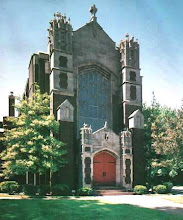- Singing an opening hymn as well as a long hymn of praise means there is a great deal of music right at the beginning of the service. This was especially evident since the church was using setting 10 of the liturgy, where the hymn of praise is itself based on a hymn tune. Perhaps the "opening hymn" works best as a call to worship that precedes the confession.
- Setting 10 is a very easy setting to learn and sing, since the tunes are already familiar. It also has a good sense of continuity through the key of F major.
- Reciting psalms can be boring, especially when mumbled in monotone. But then again singing them in a boring way isn't much better. I guess it boils down to attitude and intention.
- After years of the LBW's liturgies and singing "Glory to you, O Lord" and "Praise to you, O Christ," Luthern congregations sound awful when asked to mumble the words before and after the Gospel. If we can't proclaim them joyfully, let's go back to singing them!
- The entire hymnal should be transposed up at least a whole step. Ok, I know that's mostly because I'm a tenor who eyes the alto line with envy on many hymns. But the theory that people will sing out if we compose growly low notes for them hasn't worked out. Maybe if we asked people to project on some high notes, they'd take a deep breath and produce some sound.
- Very few people at very few churches ever do listen to a postlude.
Saturday, July 18, 2009
An organist in the pew
I had promised further reflections on my experience at St. Paul's in Missouri last Sunday, so I thought I would simply bullet point some of the things that crossed my mind during the service. Here they are, in liturgical order:
Subscribe to:
Post Comments (Atom)


No comments:
Post a Comment